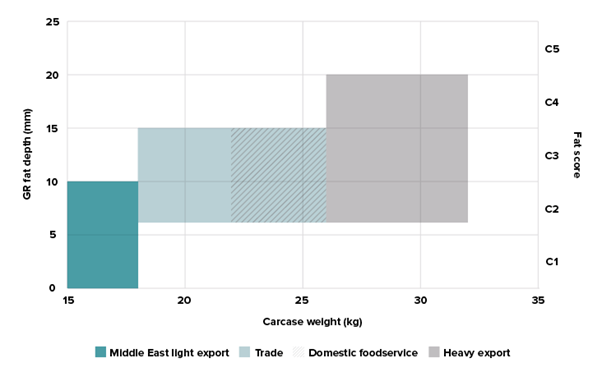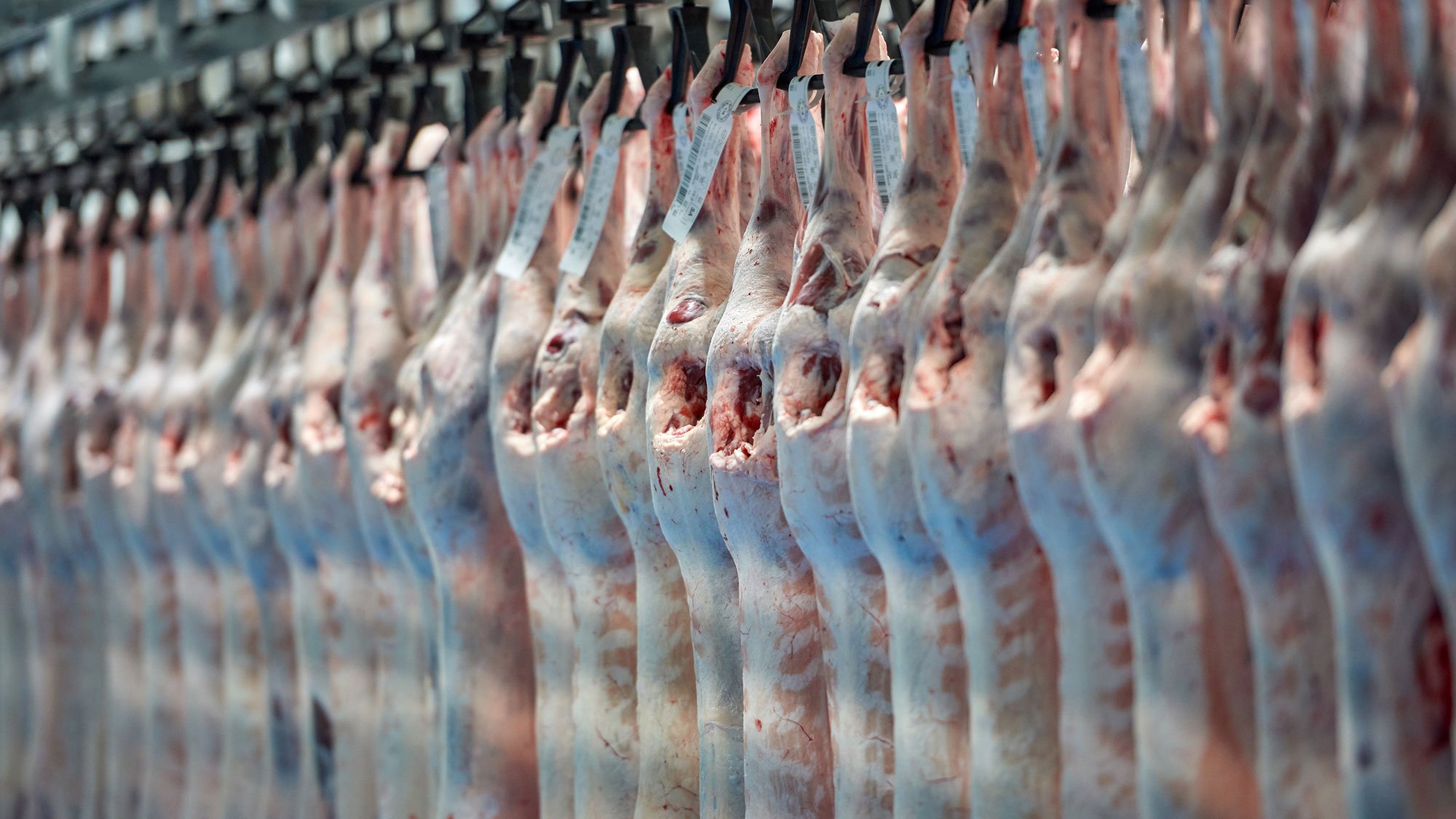Chapter 3.1 Decide what product you can produce most profitably
Chapter 3.1 Decide what product you can produce most profitably
Background information
Marketing lamb and sheepmeat comes at the end of the on-farm sector in a segmented ‘paddock to plate’ production chain (figure 3.1).
Industry has clear feedback mechanisms between the sections of the supply chain linked by the bold line but needs feedback from consumers to producers (the dotted line) to close the feedback loop. Consumer feedback is constantly evolving and often broadening. Along with the traditional consumer expectations of healthy and safe food with a great eating experience, greater emphasis is being placed on sustainability and provenance, growing to encompass not only environmental implications, but also animal welfare, social and economic factors, as well as a greater understanding of the people and place producing their food.
With better technologies and feedback, industry moves from a ‘supply chain’ model to a ‘value chain’, as value is being added to all stakeholders.
Responding to ever-evolving consumer expectations requires coordinated effort across the supply chain and integrates all parts of the farm system.
Best practice management seeks to improve the operation of the production chain links to achieve higher levels of product quality and consistency and to direct benefits to all sectors. Sheep producers may benefit from relationships with agents, processors, wholesalers and retailers along the supply chain.
The basic profit drivers of a lamb and sheepmeat enterprise include:
- Quantity of product produced per hectare;
- Lamb weaning percentages (see chapter 10.3 in MMFS Module 10 Wean More Lambs);
- Cost of production (including the cost of marketing)
- Feed use efficiency and pasture quality and quantity
- Price per kilogram received for product.
Of these factors, the amount of meat produced per hectare has the greatest impact on income and gross margins. Select the time of lambing to achieve highest lamb numbers for sale before optimising the enterprise stocking rate to achieve target growth rates (see chapter 8.3 in MMFS Module 8 Turn Pasture into Product). Lamb weaning percentages, feed use efficiency and pasture quality and quantity are the keys to profitable sheepmeat production.
At a glance
- Understand your production environment and choose a target market you can produce lambs and sheep for profitably.
- Predict lamb growth rates and plan the growth pathway to the point of sale.
- Monitor and evaluate the productivity and profitability of the production system.
Set annual production targets and timelines to enable you to monitor your business outcomes and profitability. Production targets to monitor include quantity of meat sold (kilograms per hectare), cost of production (cents per kilogram dressed weight) and price received at sale (cents per kilogram). The key decisions in a profitable system are (1) know what you aim to produce, and (2) decide on a target market.
Match the production system to land capability
Matching target markets to the land capability and production environment can be achieved by:
- Matching your stock class and nutritional requirements to the quality and availability of pastures and crops, the pattern of rainfall and the length of the growing season (see chapter 9.2 in MMFS Module 9 Boost Business with Breeding and chapter 8.3 in MMFS Module 8 Turn Pasture into Product).
Then, by:
- matching the proposed target market to the breed and type of lamb; and
- planning the finishing phase (use of pasture versus fodder crop or grain feeding) and matching this to the choice and specifications of target markets.
Decide on a target market
The specifications for lamb vary depending on the market segment being targeted. Crossbred lambs are more favoured for the lamb trade but merino lambs have a niche in particular markets. There are also various markets for hogget and mutton products, tool 3.2 provides a summary of the specifications for a range of markets for lamb and sheepmeat.
In 2019 the definition of a lamb was updated to:
‘An ovine animal that: (a) is under 12 months of age; or (b) does not have any permanent incisor teeth in wear.’
This means a lamb can cut one or both of its permanent central incisor teeth, as long as they are not in wear (figure 3.2).
The current definition is consistent with New Zealand’s definition (Australia’s biggest competitor in lamb export markets) and serves to even the playing field between the two countries. For more information see signposts.

Table 3.1 provides a summary of the important features of a range of lamb categories. Daily growth rates for lambs can vary from 400 g/day (fast growth), 250 g/day (medium growth) 150 g/day or lower (slow growth). The minimum requirement for high eating quality is a growth rate of more than 100 g/day for crossbred lambs and 150 g/day for Merino lambs.
Table 3.1 Key features of lamb market categories
Source: MLA, adapted by AWI and MLA
|
Lamb category |
Liveweight (kg) |
Hot standard carcase weight (HSCW) (kg) |
Market segment |
Estimated growth rate |
|
Weaned |
35 |
|
Store lamb |
200 |
|
Weaned |
33 |
|
Feeder |
300 |
|
Unweaned |
40 |
20 |
Domestic |
300 |
|
Carryover |
45 |
22 |
Diverse |
150 |
|
Carryover |
55 |
26 |
Heavy export |
200 |
|
Merino |
47 |
20 |
Diverse |
150 |
Tool 3.2 provides a more in-depth look at potential markets and specifications for sheepmeat.
Meeting carcase weight and fat score specifications for sheepmeat is important for successfully supplying a target market and the best financial returns.
At most processing works, sheep with 5 mm or less of GR fat (fat score 1) are not desirable and price may be penalised. In addition, under the Meat Standards Australia (MSA) carcase requirements, all sheepmeat categories must have a fat score of 2 or above and at least 6 mm of GR fat to be eligible for classification as MSA product.
Figure 3.3 provides a guide to the range of carcase weight and fat depth specifications for different markets and tool 3.3 shows you how to fat score and assess your lambs in the yards.
It is important that producers speak with their advisor, stock and station agent or livestock buyer to understand the specifications and grid prices for their target market. Doing this will ensure you meet market specifications and optimise the return for your livestock.

Know the specifications you aim to produce
Know your product and production system by measuring and recording details and evaluating performance. Use tool 3.1 to plan the average lamb growth rate to point of sale. Aim to segregate the lamb turnoff into top, middle and bottom thirds to account for the variation in the mob and apply the appropriate feeding management to achieve growth targets. Where possible, benchmark production performance and consider using a livestock adviser to increase performance and profitability. Automated, easy-to-use weighing systems have been developed for rapid weighing and sorting.
Decide on the finishing system
Pasture forage
A high energy and protein pasture to drive liveweight gain for lambs should contain 11 megajoules of metabolisable energy (MJ ME) per kilogram of dry matter (DM) at 17% crude protein (CP). Mixed species, actively growing green feed of 1,800-2,100 kg DM/ha of feed on offer (FOO) is the gold standard for young stock. Feed tests should be completed to understand the MJ ME and CP in the feed to ensure it meets the minimum requirements for your targeted liveweight gains (see chapter 8.3 in MMFS Module 8 Turn Pasture into Product).
Lot feeding
Lot feeding to finish lambs may be a viable management consideration but you should always calculate the cost versus financial gain before starting a lot feeding program (see signposts).
Aim for 2 kg or more liveweight gain per week and monitor progress to ensure the lambs are gaining weight. Record liveweight on entry to the feedlot and weigh at regular intervals to check on progress towards target sale weights.
Feeder lambs
There is increasing demand from specialist lamb finishers and lot feeders for high-quality feeder lambs. To supply this market producers should develop production systems that grow lambs to around 30 kg liveweight at 12–14 weeks of age. Aim for a turnoff weight of 33 kg liveweight minimum – see table 3.1 in chapter 3.2).
Explore market options (see chapter 3.3), build a supply chain relationship with finishers and use high genetic merit sires for carcase attributes, including lean meat yield (LMY) and eating quality (EQ) (see chapter 9.2 in MMFS Module 9 Boost Business with Breeding) and ensure health management processes suit the production system (see chapter 11.2 in MMFS Module 11 Healthy and Contented Sheep).
To maximise turnover and profit, maintain a focus on production efficiency and turnoff (kilograms of lamb produced per hectare). See tool 1.10 in MMFS Module 1 Plan for Success for a range of industry, business and production benchmarks you can use to measure efficiency.
Calculate your cost of production
Calculating your cost of production (quoted in cents per kilogram dressed weight) is important to identify options for improving enterprise performance. It can be the first step in making changes to the production system (see tool 1.7 in MMFS Module 1 Plan for Success).
To calculate whether lot feeding lambs is a viable and economically sound management decision use the Feedlot Calculator (see signposts). This gross margin calculator enables you to enter real-time production, economic and feeding scenarios to estimate likely profit for lot feeding lambs.
SIGNPOSTS
Read
USE
A tool to help you determine your cost of production for sheep, beef and goats and compare performance annually.
Enables producers to estimate likely profit for a lamb feedlotting enterprise under various scenarios.
Latest pricing, reporting, forecasts and analysis for Australian and international red meat markets.






